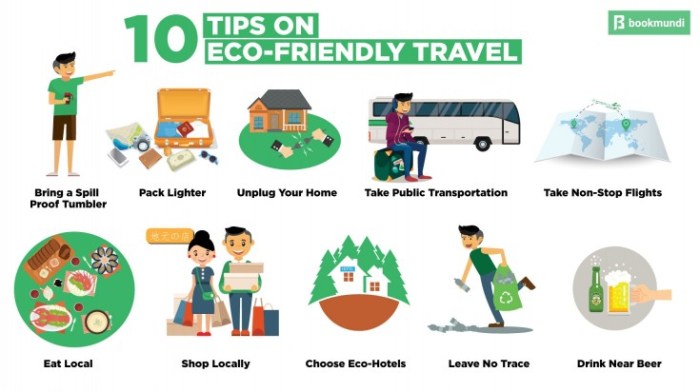Embark on a journey of sustainable travel with our comprehensive guide to eco-friendly travel tips. From mindful transportation to responsible accommodation, we’ll explore the best practices to minimize your environmental impact while maximizing your travel experiences.
As global citizens, it’s crucial to adopt sustainable practices in all aspects of our lives, including travel. Eco-friendly travel empowers us to explore the world while preserving its beauty for future generations.
Transportation

Choosing eco-friendly transportation options can significantly reduce your travel’s carbon footprint. Consider the following modes of transport for your next trip:
Public Transportation
Buses, trains, and subways are generally more environmentally friendly than cars, as they transport multiple passengers at once, reducing per-person emissions. Electric or hybrid buses and trains have even lower emissions.
Walking and Cycling
For short distances, walking or cycling is an excellent zero-emission option. It promotes physical activity and allows you to experience the local surroundings up close.
Electric Vehicles
Electric vehicles (EVs) produce zero tailpipe emissions, making them a cleaner alternative to gasoline-powered cars. Look for charging stations along your route to ensure you can power up your EV during your trip.
For eco-friendly travel, consider packing light, reusing water bottles, and opting for sustainable accommodations. While exploring, prioritize activities that minimize environmental impact, such as hiking or snorkeling. For a tropical getaway, discover the best beaches in the Caribbean , known for their pristine waters and lush landscapes.
Remember to respect local customs and leave no trace behind to preserve these natural wonders for future generations.
Ride-Sharing
Ride-sharing services, such as Uber and Lyft, can reduce emissions by consolidating passengers into fewer vehicles. Opt for electric or hybrid ride-sharing options for an even lower carbon footprint.
When planning your next family vacation, consider incorporating eco-friendly travel tips to reduce your environmental impact. Look for family-friendly resorts that prioritize sustainability through energy-efficient practices, waste reduction, and support for local communities. By choosing eco-conscious options, you can minimize your carbon footprint while creating lasting memories with your loved ones.
Train vs. Plane
For longer distances, trains are often more environmentally friendly than planes. Trains emit less carbon dioxide per passenger-mile and offer scenic views along the way.
Planning an Eco-Friendly Itinerary
To minimize transportation emissions, plan your itinerary carefully:
- Combine multiple destinations into a single trip to reduce the number of flights or long-distance drives.
- Choose destinations accessible by public transportation, walking, or cycling.
- Look for accommodations near attractions and amenities to minimize the need for transportation.
- Consider offsetting your carbon emissions through organizations that support renewable energy or reforestation projects.
Accommodation

Finding eco-friendly accommodations can enhance your sustainable travel experience. Consider the following tips to make informed choices:
When selecting hotels, guesthouses, or vacation rentals, prioritize establishments with sustainability certifications such as LEED (Leadership in Energy and Environmental Design), Green Key, or EarthCheck. These certifications indicate adherence to environmental standards in areas like energy efficiency, water conservation, and waste management.
Eco-Friendly Amenities and Features
- Energy-efficient lighting and appliances: Look for accommodations that use LED bulbs, energy-saving appliances, and motion sensors to minimize energy consumption.
- Water-saving fixtures: Opt for accommodations with low-flow showerheads, faucets, and toilets to conserve water.
- Sustainable building materials: Consider accommodations constructed with eco-friendly materials like bamboo, recycled wood, or natural stone.
- Organic and locally sourced amenities: Support accommodations that provide organic toiletries, locally sourced linens, and biodegradable cleaning products.
- Waste reduction initiatives: Choose accommodations with recycling programs, compost bins, and reusable amenities to reduce waste.
Activities
Participating in eco-friendly activities not only enhances your travel experience but also supports local communities and protects the environment. Choose activities that minimize environmental impact, respect local customs, and promote sustainable practices.
When embarking on your next adventure, consider implementing eco-friendly travel tips to minimize your environmental impact. From reducing your carbon footprint to supporting local communities, sustainable practices can enhance your journey. However, if luxury is more your style, you can explore luxury travel tips that prioritize responsible tourism.
Ultimately, whether you choose to travel eco-consciously or indulge in lavish experiences, remember that mindful travel practices can enrich your adventures while preserving the planet for future generations.
Wildlife Viewing and Nature Walks
Engage in wildlife viewing and nature walks responsibly. Stick to designated trails, avoid disturbing wildlife, and refrain from feeding or interacting with animals. Use binoculars or cameras with long lenses to observe wildlife from a distance.
Respecting Local Customs and Traditions
Be mindful of local customs and traditions while engaging in activities. Dress appropriately, ask permission before taking photographs, and avoid disrespectful behavior. Learn about local etiquette and cultural practices to ensure you interact respectfully with the community.
Food and Drink
Eating and drinking are essential parts of any travel experience. But they can also have a significant environmental impact. By making conscious choices about what you eat and drink, you can help reduce your footprint while still enjoying delicious meals.
Supporting Sustainable Restaurants and Cafes
When choosing where to eat, look for restaurants and cafes that prioritize sustainability. These businesses often use local and seasonal ingredients, compost food waste, and use eco-friendly packaging. You can find sustainable restaurants by using online directories or asking for recommendations from locals.
Eating Local, Seasonal, and Plant-Based Foods
Eating local and seasonal foods is a great way to reduce your carbon footprint. When food is transported long distances, it requires a lot of energy and produces greenhouse gases. By eating local, you can help reduce these emissions.
Seasonal foods are also more nutritious than foods that are grown out of season. When fruits and vegetables are in season, they are at their peak of ripeness and flavor. Eating seasonal foods can help you get the most nutrients from your diet.
Plant-based foods have a lower environmental impact than animal-based foods. Animal agriculture requires a lot of land, water, and energy. By eating more plant-based foods, you can help reduce your impact on the environment.
Reducing Food Waste
Food waste is a major environmental problem. When food is wasted, it ends up in landfills, where it decomposes and produces methane, a potent greenhouse gas.
There are many ways to reduce food waste while traveling. Here are a few tips:
* Order smaller portions.
* Share meals with friends or family.
* Take leftovers home with you.
* Compost food waste.
By making small changes to your eating habits, you can help reduce your environmental impact and still enjoy delicious meals while traveling.
Packing and Gear: Eco-friendly Travel Tips

Eco-friendly packing involves using reusable and biodegradable items, reducing waste, and minimizing luggage emissions.
Reusable Essentials
- Reusable water bottle
- Reusable shopping bag
- Reusable cutlery, straw, and utensils
- Reusable containers for food and toiletries
Biodegradable Products, Eco-friendly travel tips
- Bamboo toothbrush
- Biodegradable soap and shampoo
- Compostable garbage bags
- Natural insect repellent
Packing Materials
Choose reusable or recyclable packing materials, such as cloth bags, cardboard boxes, and packing paper. Avoid single-use plastics like bubble wrap and plastic bags.
Packing Light
Pack only essential items to reduce weight and minimize luggage emissions. Consider using packing cubes or vacuum bags to compress clothing and save space.
Offsetting Carbon Footprint
Carbon offsetting is a way to reduce the impact of your travel emissions by supporting projects that remove carbon dioxide from the atmosphere. This can be done through a variety of methods, such as investing in renewable energy projects, planting trees, or supporting carbon capture and storage technologies.
Calculating Your Carbon Footprint
The first step to offsetting your carbon footprint is to calculate how much carbon dioxide your trip will produce. This can be done using a variety of online calculators, such as the one provided by the Environmental Protection Agency (EPA). Once you know your carbon footprint, you can purchase carbon offsets to compensate for the emissions you will produce.
Purchasing Carbon Offsets
There are a number of different ways to purchase carbon offsets. You can buy them directly from project developers, through brokers, or through non-profit organizations. When choosing a carbon offset project, it is important to look for projects that are certified by a reputable third-party organization, such as the Gold Standard or the Verified Carbon Standard. This ensures that the project is meeting the highest standards of environmental integrity.
Benefits of Offsetting Your Carbon Footprint
There are a number of benefits to offsetting your carbon footprint. First, it helps to reduce the impact of your travel on the environment. Second, it supports the development of renewable energy and other low-carbon technologies. Third, it can help to raise awareness about the importance of climate change.
Final Conclusion
By embracing these eco-friendly travel tips, you’ll not only reduce your carbon footprint but also contribute to the well-being of local communities and ecosystems. Remember, every conscious choice you make as a traveler has a positive ripple effect, shaping a more sustainable future for all.
Query Resolution
What are some eco-friendly transportation options?
Consider trains, buses, or ride-sharing services for short-distance travel. For longer journeys, opt for airlines with fuel-efficient aircraft and carbon offset programs.
How can I find eco-friendly accommodations?
Look for hotels and guesthouses with sustainability certifications, such as LEED or Green Key. These certifications ensure that the property adheres to environmental standards.
What are some tips for reducing food waste while traveling?
Order smaller portions, share meals, and avoid buffets. Pack reusable containers for leftovers and snacks to minimize single-use packaging.